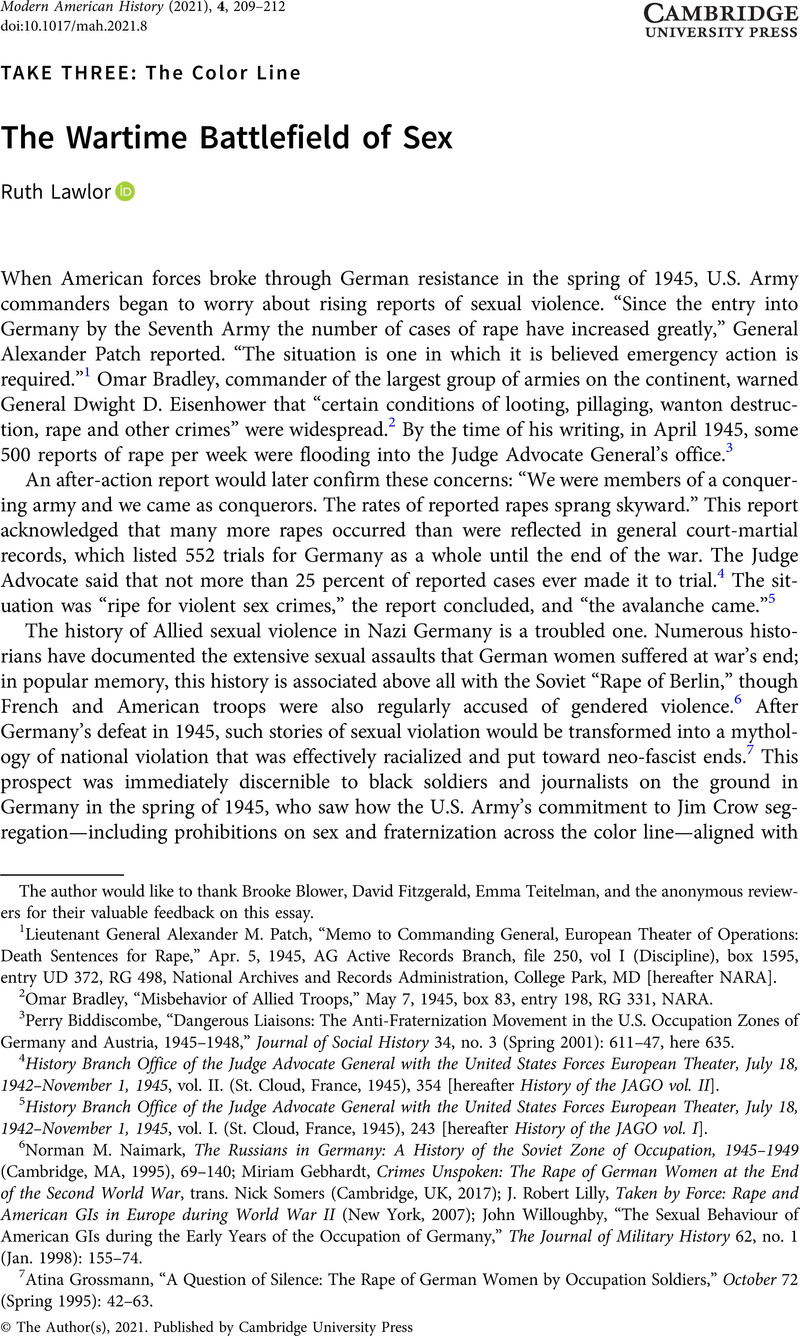No CrossRef data available.
Article contents
The Wartime Battlefield of Sex
Published online by Cambridge University Press: 26 May 2021
Abstract

- Type
- Take Three
- Information
- Copyright
- Copyright © The Author(s), 2021. Published by Cambridge University Press
Footnotes
The author would like to thank Brooke Blower, David Fitzgerald, Emma Teitelman, and the anonymous reviewers for their valuable feedback on this essay.
References
1 Lieutenant General Alexander M. Patch, “Memo to Commanding General, European Theater of Operations: Death Sentences for Rape,” Apr. 5, 1945, AG Active Records Branch, file 250, vol I (Discipline), box 1595, entry UD 372, RG 498, National Archives and Records Administration, College Park, MD [hereafter NARA].
2 Omar Bradley, “Misbehavior of Allied Troops,” May 7, 1945, box 83, entry 198, RG 331, NARA.
3 Biddiscombe, Perry, “Dangerous Liaisons: The Anti-Fraternization Movement in the U.S. Occupation Zones of Germany and Austria, 1945–1948,” Journal of Social History 34, no. 3 (Spring 2001): 611–47CrossRefGoogle Scholar, here 635.
4 History Branch Office of the Judge Advocate General with the United States Forces European Theater, July 18, 1942–November 1, 1945, vol. II. (St. Cloud, France, 1945), 354 [hereafter History of the JAGO vol. II].
5 History Branch Office of the Judge Advocate General with the United States Forces European Theater, July 18, 1942–November 1, 1945, vol. I. (St. Cloud, France, 1945), 243 [hereafter History of the JAGO vol. I].
6 Naimark, Norman M., The Russians in Germany: A History of the Soviet Zone of Occupation, 1945–1949 (Cambridge, MA, 1995), 69–140Google Scholar; Gebhardt, Miriam, Crimes Unspoken: The Rape of German Women at the End of the Second World War, trans. Somers, Nick (Cambridge, UK, 2017)Google Scholar; Lilly, J. Robert, Taken by Force: Rape and American GIs in Europe during World War II (New York, 2007)Google Scholar; Willoughby, John, “The Sexual Behaviour of American GIs during the Early Years of the Occupation of Germany,” The Journal of Military History 62, no. 1 (Jan. 1998): 155–74CrossRefGoogle ScholarPubMed.
7 Grossmann, Atina, “A Question of Silence: The Rape of German Women by Occupation Soldiers,” October 72 (Spring 1995): 42–63CrossRefGoogle Scholar.
8 The most famous example of this problem in Europe was the Leroy Henry case, tried in Britain in 1944. See Mary Roberts, Louise, “The Leroy Henry Case: Sexual Violence and Allied Relations in Great Britain, 1944,” Journal of the History of Sexuality 26, no. 3 (Sept. 2017): 402–23CrossRefGoogle Scholar. German fears stemmed in part from memories and the surrounding mythology of the Black Horror on the Rhine, a campaign by German officials to discredit the French occupation of the Rhineland in the early 1920s by accusing colonial troops of sexual violence. See Wigger, Iris, “‘Black Shame’—The Campaign against ‘Racial Degeneration’ and Female Degradation in Interwar Europe,” Race & Class 51, no. 3 (Jan. 1, 2010): 33–46CrossRefGoogle Scholar.
9 Roberts, Mary Louise, What Soldiers Do: Sex and the American GI in World War II France (Chicago, 2013), 239–54CrossRefGoogle Scholar.
10 “A Double Standard of Morals,” The Chicago Defender, Apr. 28, 1945, 12; Franklin H. Williams, “Memorandum to Walter White,” Feb. 28, 1947, file Soldier Trouble: 1946–47, box II B158, National Association for the Advancement of Colored People Records, 1842–1999 [hereafter NAACP], Library of Congress, Washington DC [hereafter LOC].
11 History of the JAGO vol. I, 249.
12 “Memorandum from Assistant Chief of Staff,” Apr. 2, 1945, box 43, entry 240R, RG 331, NARA.
13 Ruthie Giles, “Letter to Walter White,” May 18, 1945, folder 5, box II B160, NAACP, LOC.
14 “Dodson, George, Van Riper, Arthur, and Placide, Budwin Jr. Record of Trial by General Court Martial,” Nov. 1, 1945, CM 309482, National Personnel Records Center, St. Louis, MO [hereafter NPRC]; History of the JAGO vol. I, 246.
15 “Plea for Clemency,” undated, folder Austin, Clayton F. Record of Trial by General Court Martial, box CM 394520, NPRC.
16 “A Double Standard of Morals.”
17 History of the JAGO vol. I, 246–8.
18 “United States v. Private Walter P. Slawkawski (32828457), 511th Engineer Light Ponton Company,” Apr. 27, 1945, Board of Review CM ETO 12329, in Holdings and Opinions Board of Review: Branch Office of the Judge Advocate General with the European Theater of Operations, vol. 25 (Washington, DC, 1946), 109–16, here 113, LOC.
19 “Diaz, Francisco R. Transcript of Trial,” Apr. 13, 1945, Diaz, Francisco R. Record of Trial by General Court Martial, CM 307069, NPRC.
20 “United States v. Private Francisco R. Diaz (38440587), Battery A, 41st Field Artillery Battalion,” Aug. 16, 1945, Board of Review CM ETO 10375, in Holdings and Opinions Board of Review: Branch Office of the Judge Advocate General with the European Theater of Operations, vol. 22 (Washington, DC, 1946), 247–52, here 251, LOC.
21 History of the JAGO vol. I, 13.
22 Robert P. Patterson, “Letter to General Dwight D. Eisenhower,” in History of the JAGO, vol. II, 525–6; Franklin H. Williams, “Memorandum to Thurgood Marshall,” Nov. 30, 1948, folder 9, box II B153, NAACP, LOC.





